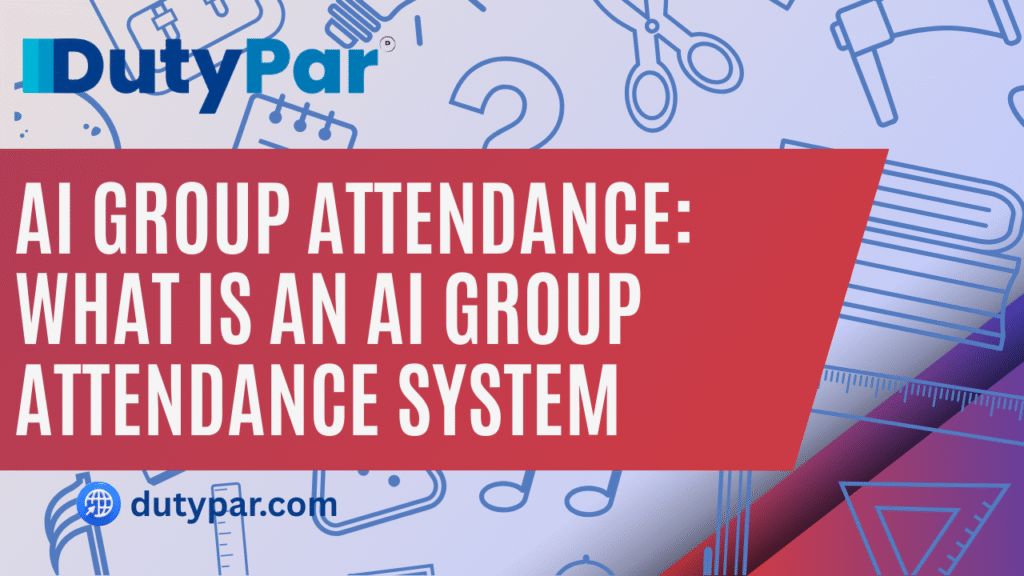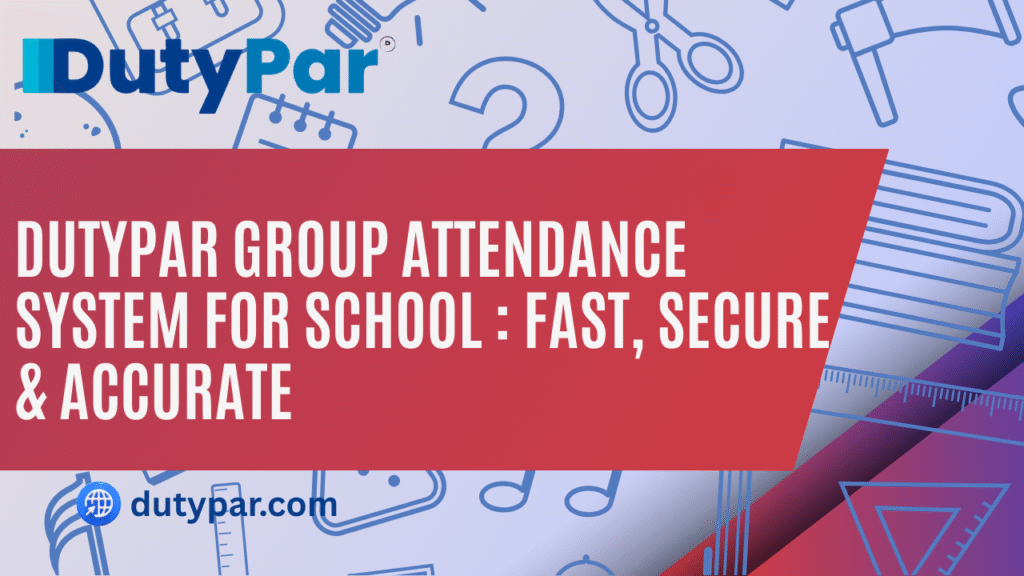
Table of contents
- What is a Group Attendance System?
- What makes an AI Attendance System different?
- How an AI Group Attendance System works — step by step
- Core features to expect
- Real benefits for schools and businesses
- Table: Traditional vs AI Group Attendance vs AI Attendance System
- Security and privacy concerns
- Accuracy and false matches
- Deployment and cost
- Practical tips for smooth adoption
- Example: DutyPar and real classroom use
- The future of group attendance
- Conclusion
A modern Group Attendance System helps schools and offices mark many people at once. An AI Attendance System uses artificial intelligence to make that simple. An AI Group Attendance System combines both ideas. It uses face recognition and smart checks to mark groups quickly and accurately.
This article explains the core idea. It shows how these systems work. It also explains benefits, security, and a clear example. The language is simple. Sentences stay short. You can use this for a blog or for decision-making.
What is a Group Attendance System?
The Group Attendance System is a tool for teachers or supervisors to take an entire classroom of students or employees at once using a single image. It detects the faces within the photo and then uses the profile photos stored in the Group Attendance System to match the faces in the image to the corresponding profiles, and automatically populate the names of individuals that were present in the image.
Previously, the Group Attendance System required manual entry of each student’s name from a list provided by the teacher or supervisor, which was time-consuming and error-prone due to the number of manual entries. The Group Attendance System automates this process, allowing staff to spend less time entering names and minimizing the chance for errors when utilizing the Group Attendance System.
What makes an AI Attendance System different?
Machine learning models are used in AI attendance systems to identify faces, regardless of time of day, by using machine learning methods. AI Attendance Systems detect live faces (to prevent fraud) as well as provide verification of location through GPS and/or GPS via geofencing.
AI Attendance Systems provide real-time processing of images, as well as continuous improvement of their capabilities (i.e., through data processing) and automatically generate sophisticated reports for all managers in real time or through the use of downloadable Excel spreadsheets.
How an AI Group Attendance System works — step by step
- A teacher or supervisor opens the app.
- They take a group photo in the classroom or meeting area.
- The AI detects faces in the photo.
- The system matches faces with IDs on file.
- It marks attendance for each person found.
- It syncs the result to the cloud.
- Admins view reports on the dashboard.
This flow keeps each step short. It limits human work. It also reduces errors and proxy attendance.
Core features to expect
A good AI Group Attendance System should include:
- Fast face recognition.
- Live face detection to stop photos of photos.
- GPS validation or geofencing.
- Group photo handling and row-wise marking.
- Real-time sync and reporting.
- Easy export to Excel or other HR tools.
These features help scale attendance across many classes or sites. They also save large amounts of staff time.
Real benefits for schools and businesses
An AI Attendance System drives clear value. It saves time, improves accuracy, reduces proxy attendance and also improves record keeping.
The requirement of multiple cameras or teacher phone camera(s) to record an entire class can be done through a single camera or self recording teacher phone in just seconds, therefore allowing for more Instructional time available for teachers. Studies and empirical evidence support the idea that time savings associated with AI systems replacing manual processes can result in many hours saved by using less time tracking systems. For instance, an AI platform could achieve an average of 5 mins of saved instructional time for each tutorial session (i.e. class) and approximately 130 instructional indoor hours on an annual basis.
Business entities can utilize these systems to better enforce equitable time-tracking for employees, thereby minimising payroll disputes. Additionally, this type of technology provides better metrics that will allow business management to efficiently plan for staffing, equipment scheduling, etc.
Table: Traditional vs AI Group Attendance vs AI Attendance System
| Aspect | Traditional Attendance | AI Group Attendance System | AI Attendance System (full) |
|---|---|---|---|
| Time per class | 5–15 minutes | 10–30 seconds | 5–30 seconds |
| Accuracy | Low | High | Very high |
| Proxy prevention | Weak | Strong | Very strong |
| Real-time reports | No | Yes | Yes |
| Location verification | No | GPS option | GPS + geofence |
| Cost over time | Medium | Low | Low to medium |
| Ease of use | Moderate | Easy | Very easy |
This table helps you compare options at a glance. It shows why AI systems win in speed and reliability.
Security and privacy concerns

Privacy concerns exist with face recognition technology, and users of that tech should treat their data with great caution, following local laws and school policy for creating, handling, and storing face recognition data. Use encrypted data storage and a secure access control mechanism. Avoid collecting any more than the bare minimum data required to perform your task. Ensure that all individuals using the system are aware of the use of their images and attendance information.
When evaluating systems, look for strong systems that focus on data governance. These systems will typically have features such as encryption, role-based access, and auditing capabilities to help protect user privacy and foster trust.
Accuracy and false matches
Quality data creates AI models. The greater the number of quality pictures, the less false matches. Quality lighting and consistency of how you capture photos increase this.
A robust system must offer viable alternatives when looking to match against the AI. In the case that the AI isn’t able to produce a match, your app should allow a manual verification of that match. This hybrid methodology enables accurate record-keeping while permitting users to continue using your service.
Deployment and cost
Deployment can be cloud-based or hybrid. Cloud systems are quick to set up. They require internet access for syncing. Hybrid systems store data locally and sync later if needed. These systems work well across low-connectivity sites.
Initial cost varies. Cloud solutions can have subscription fees. Edge devices, like AI cameras, add upfront cost. Still, many schools and institutions find fast payback through saved hours and reduced device costs. The PDF I analyzed shows that AI solutions can be far more cost effective than older biometric devices. DutyPar for Educational Institu…
Practical tips for smooth adoption
Start with a pilot. Test one class or department first. Train staff with short sessions. Keep user guides simple. Monitor results for a month. Use feedback to adjust settings. Use reports to detect edge cases and refine the model.
Make sure leadership supports the change. Communicate why the system helps staff and students. Transparency lowers resistance.
Example: DutyPar and real classroom use
DutyPar is an AI Group Attendance System built for educational settings. It lets teachers take a class photo and mark attendance in seconds, supports both individual and group attendance workflows. It also offers messaging, reporting, and assessment features. The platform claims time savings and cost benefits for schools. It supports instant verification and row-wise marking for classrooms. These features make it a practical case of AI applied to group attendance. DutyPar for Educational Institu…
The future of group attendance
AI will keep improving. Future systems will add better edge processing. Cameras will run models on-device for faster results. AI will link attendance with learning outcomes and safety systems. These advances will make attendance more than a record. It will become a tool for better time use and better learning.
Conclusion
An AI Group Attendance System offers a fast, fair, and secure way to mark many people at once. An AI Attendance System brings accuracy, location checks, and real-time reporting. Together, these tools save time and cut errors.
If you manage classrooms or teams, testing an AI Group Attendance System is wise. Start small. Watch results. Expand when you see clear gains. The right system brings more time for teaching and less time on paperwork. It delivers fair records, strong security, and smoother daily operations.
View : IndoAI Technologies

